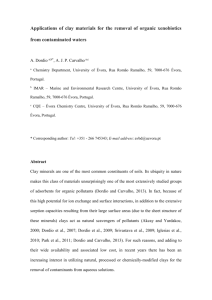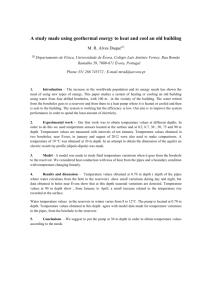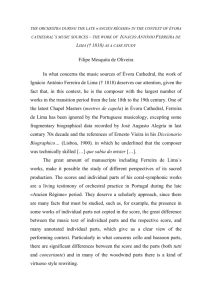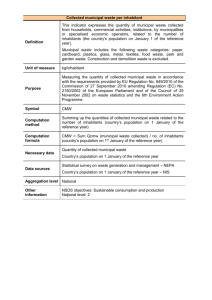"Utopia and Reality: from Etienne de Gröer to the late 20th century
advertisement
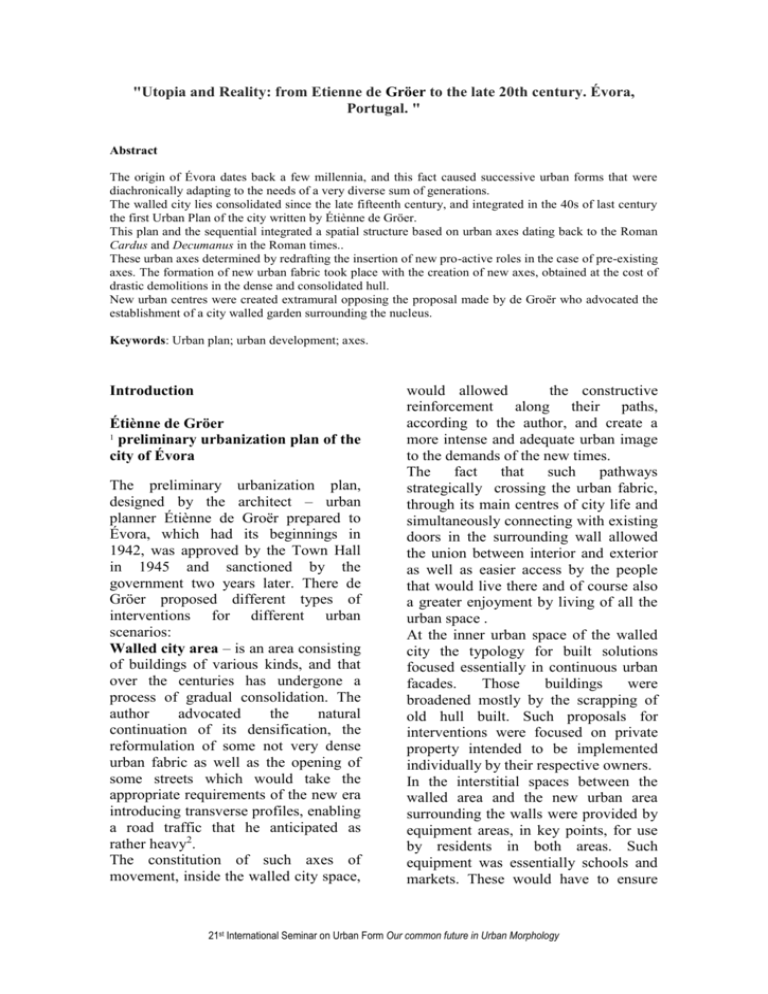
"Utopia and Reality: from Etienne de Gröer to the late 20th century. Évora, Portugal. " Abstract The origin of Évora dates back a few millennia, and this fact caused successive urban forms that were diachronically adapting to the needs of a very diverse sum of generations. The walled city lies consolidated since the late fifteenth century, and integrated in the 40s of last century the first Urban Plan of the city written by Étiènne de Gröer. This plan and the sequential integrated a spatial structure based on urban axes dating back to the Roman Cardus and Decumanus in the Roman times.. These urban axes determined by redrafting the insertion of new pro-active roles in the case of pre-existing axes. The formation of new urban fabric took place with the creation of new axes, obtained at the cost of drastic demolitions in the dense and consolidated hull. New urban centres were created extramural opposing the proposal made by de Groër who advocated the establishment of a city walled garden surrounding the nucleus. Keywords: Urban plan; urban development; axes. Introduction Étiènne de Gröer 1 preliminary urbanization plan of the city of Évora The preliminary urbanization plan, designed by the architect – urban planner Étiènne de Groër prepared to Évora, which had its beginnings in 1942, was approved by the Town Hall in 1945 and sanctioned by the government two years later. There de Gröer proposed different types of interventions for different urban scenarios: Walled city area – is an area consisting of buildings of various kinds, and that over the centuries has undergone a process of gradual consolidation. The author advocated the natural continuation of its densification, the reformulation of some not very dense urban fabric as well as the opening of some streets which would take the appropriate requirements of the new era introducing transverse profiles, enabling a road traffic that he anticipated as rather heavy2. The constitution of such axes of movement, inside the walled city space, would allowed the constructive reinforcement along their paths, according to the author, and create a more intense and adequate urban image to the demands of the new times. The fact that such pathways strategically crossing the urban fabric, through its main centres of city life and simultaneously connecting with existing doors in the surrounding wall allowed the union between interior and exterior as well as easier access by the people that would live there and of course also a greater enjoyment by living of all the urban space . At the inner urban space of the walled city the typology for built solutions focused essentially in continuous urban facades. Those buildings were broadened mostly by the scrapping of old hull built. Such proposals for interventions were focused on private property intended to be implemented individually by their respective owners. In the interstitial spaces between the walled area and the new urban area surrounding the walls were provided by equipment areas, in key points, for use by residents in both areas. Such equipment was essentially schools and markets. These would have to ensure 21st International Seminar on Urban Form Our common future in Urban Morphology not only pedestrian access for the resident populations in its area of influence but also effective response to to the distant residential areas: to this end, these spaces must always be located along the structural axis, close to the main gates of the ancient city and they should be located or from inside or immediately in the surrounding area and should also having parking areas next to them. The new urban perimeter surrounding the city walls – Outside the entire walled urban space, that at that time was still very little occupied, de Groër proposed the construction of a new urban area3 with characteristics of “garden city” surrounding the limited ancient core of the metropolis to the existing date by creating a kind of a “lung” (Brito, V., Ferreira, CT 2007) that would allow a better environmental quality4. In planned urban space, the building typology proposed consisted of detached, semi-detached or isolated dwellings, where free private land contributed to the creation of a continuous green environment for the entire rural surrounding area (Simplício, M. D. V. M., 2009). According to the areas of each of the respective batches were allowed constructions and those contributed to the distribution of socio economic hierarchy of the future population that would reside in the area. Some wards have social housing such as the Bairro da Câmara where the buildings are located in twinned lots although had building areas and compartments of diminutive dimensions ensuring reduced costs. Some of the lots in the new area to urbanize consisted at that time by rural land for which de Groër advocated different urban typologies that actually were informally constituted. Such plots were subdivided into parcels described as “avos” usually “sold” at low cost, or even donated, by the owners of the estates to rural workers of its land thus creating subtle ties of dependence because those “plots” were still legally belonging to their rightful owners despite sometimes these workers have be building their houses on those lands . We may refer as examples of these wards Almeirim (east of the metropolis), Bacêlo, Coronheira, Granito (located north of the city), and Casinha (located in the west of the city). These cadastral underlying situations were not considerate when de Groër plan was developed and approved (Carvalho, J., 1990). Present Having this as a groundwork plan, and after successive urbanization plans that introduced updates resulting from new requirements we came into this reality as one can see is substantially different from that recommended by de Groër proposal in the 40s of XX century . Walled city area – for the space in question, de Groër opted for the maintenance of the medieval urban fabric without significant interventions (one of the principles advocated by de Groër in urbanization plans in which he participated) that nothing could jeopardize the unity of urban space. The rehabilitation of the buildings was aspirated, though not a fully realized goal. The private property being in possession of more than one owner, due to successive inheritances, substantially delayed this aspiration yielding properties and punctually kept them up slightly degraded. The level of outstanding public spaces interventions were being carried out in the most emblematic squares of the metropolis. In the buried infrastructure existed special care in replacing it considering 21st International Seminar on Urban Form Our common future in Urban Morphology its age and current requirements in particular with regard to the water, sewer, gas and optic fiber. In more recent times the decrease of economic power or the population either of the Town Hall or the housing cooperatives, contributed to the decrease of urban interventions of social nature. Alternatively housing cooperatives triggered more targeted interventions to classes of larger economic power by tampering with the original spirit of intervention programs and being example the allotment of CTT (Correios de Portugal) situated in the walled interior. The installation of hotel properties located within the historic center, or in large spaces still vacant as was the case for example of the Hotel Mar de Ar Wall built in the old Quinta da Palmeira, or even reusing old buildings such as the Hotel Mar de Ar aqueduct installed in the Palácio dos Sepúlvedas that was adopted for the new requirements resulting of the observed from the growing tourist demand. New urban perimeter surrounding the city walls – Urban space delimited by increasing and actualization of urbanization plans was structured by building a set of streets, some of radial nature, other circulars that allow the interconnection of various districts scattered throughout the area surrounding the historic centre. It should be noted that part of this road structure has not been fully realized for various reasons. Regarding to the housing typology, mainly directed to the lower classes, there were promoted by the state, social housing developments built vertically countering all the original spirit of the 40s. That was the case of the development of the Cruz da Picada (located to the west of the city) the largest urban complex built vertically for social rental which projective features had not appropriate social and cultural characteristics for the population that would inhabit it. Concerning private projects there were implemented with some brands of typologies features of single-family, semi-detached dwellings or individual, as the wards of Tapada and Vista Alegre, and dated to the mid-twentieth century being located to the west of the city (Carvalho, J., 1990). However, all the vast space surrounding the city walls was increasingly taken over by new illegal wards that after April 1974 were successively converted and legalized through municipal lots or detailed plans (Carvalho , J. , 1990) . Later, in the 80s of the twentieth century, the Tapada and Vista Alegre as they were already sold out at the level of building plots , there were provided the triggering of a new process of subdivision with identical and temporally characteristics adapted to new generations yielding characteristics the allotment of Vila Lusitano situated to the west of the city. It was however at the level of C.M.E. (Town Hall of Évora) and of the housing cooperatives that much of the surrounding area was built through the creation of lots intended for housing at controlled costs that, in some individual cases, came to take on the characteristics of evolutionary housing, as exemplified by the case of Malagueira (to the west of the city), some lots in Granito Centro and Bacêlo (both to the north of the city). Among the various operations of the allotments with controlled costs5 as we can mention the exemple of Malagueira, António Sérgio, Casinha and Alto dos Cucos (all to the west of the city) and Granite Centre among others (Carvalho, J., 1990). These are some examples that ensured a cohesive and quality architecture and urbanism greatly due to 21st International Seminar on Urban Form Our common future in Urban Morphology the conditions that such types of programs demanded from their promoters.6 After nearly seven decades passed between the proposed by de Groër 's preliminary plan, and through the development and implementation of various development schemes and detailed plans that sought to resolve the problem posed by the existence of many illegal housing units genesis dispersed and separated the walled core. With current legalization, infrastructures and densification has been a challenge only in part outdated. Its relationship with the historic centre by the solution of building urban axes was increased by its integration as it would be an effective and inexpensive method of obtaining continuous urban image over long distances. Similar increase of the urban area through private initiatives significantly widened, though accomplished through a whole set of new illegal buildings consisting of “lots” of large dimensions – the so-called “small farms” – coming again hamper the treatment of space, making the hybrid relationship between urban and rural. It will be an overview that new decades and new generations will have to equate making the reality of today in utopia of tomorrow. With regard to collective facilities scheduled on the edge of the urban area they were located according to the growth of housing units in development, emphasizing schools, on their various levels of education, parish councils, sports amenities and cultural facilities among others, day-care centres and the construction of a new cemetery thereby responding to the substantial increase in estimated population. Conclusions Overall, from what was proposed in the de Groër’s preliminary plan, some of the recommended solutions have been implemented, such as plots of residential areas being the example of Bairro da Câmara, and Bairro da Tapada. Regarding the proposed road system, many of the main roads have suffered notable adjustments in terms of location and route. The cross sections also suffered adjustments resulting from the new urban concepts. The proposed architectural typologies, with detached single family dwelling remained in some cases. With the introduction of new social concerns due to the Revolução de Abril, pilot experiences were introduced, such as the case of the Bairro da Malagueira, where it was achieved a high constructive density with single-family residential lots. Another way of trying to address the problem of housing shortage was completed in the Bairro da Cruz da Picada, state initiative to social renting, using a project type of housing in height, which was implemented in cities across the country. As for equipment, the proposal for a central trucking zone adjacent to the Praça do Giraldo was relocated in Rua da República, inside the Old town, and was later built on the municipal lands adjacent to the Cemitério dos Remédios. The construction of a Municipal Market proposed for the Portas de Alconchel, was relocated with a much wider dimension as a supply market of the entire region, close to Bairro de S. José da Ponte. The utopia proposed by de Groër’s preliminary plan was completed in a substantially differential way due to the natural socio-economic development of a society that has undergone significant structural changes due to very profound political changes that have altered the existing paradigm. The new political paradigm allowed new urban experiences, some of which 21st International Seminar on Urban Form Our common future in Urban Morphology examplary, as the case of Bairro da Malagueira. References BRITO, V.: Camarinhas, C. T., (2007), “Elementos para o estudo do plano de urbanização da cidade de Lisboa (1938)”, Cadernos do Arquivo Municipal, Direcção Municipal de Cultura/ Departamento de Bibliotecas e Arquivos/Arquivo Municipal de Lisboa, n.º 9. CARVALHO, J., (1990), Évora, Administração Urbanística, Câmara Municipal de Évora, Évora. Carta de Atenas, Charter of Athens, Athens Charter about Modern Urbanism – Athens 1933, IV International Congress of Modern Architecture http://portal.iphan.gov.br/portal/baixaFc dAnexo.do?id=233, acessed em 10 of Maio of 2014. SIMPLÍCIO, M. D. V. M., (2009), Evolução da Estrutura Urbana de Évora: o século XX e a transição para o século XXI. V. V. A. A. (2001), Riscos de um Século – Memórias da Evolução Urbana de Évora, Coordenação Editorial: Almeida, C., Edição: Câmara Municipal de Évora. Divisão de Assuntos Culturais – Arquivo 1 Étiènne de Groër was born in Warsaw in 1882. He obtained his degree in Architecture from the Imperial Academy of Fine Arts in St. Petersburg. About 1920 he moved to France where he collaborated on numerous development urbanization plans and in various cities. In 1936 he was naturalized French and joined the Institute of Urbanism of Paris, where as a lecturer was responsible for the subject area where it was taught the principles of the garden city. Later, in the 1930s and 1940s, he, with the architects Donat-Alfred Crouch and Luigi Dodi, was invited by Duarte Pacheco to make development urbanization plans in various cities in Portugal, introducing the new urban principles that then were in force in Europe, of which we can underline the concept of the garden city that had been set by Howard Ebenezer. He became one of the main planners of the new State, being in charge of the preparation of preliminary plans or land development plans of various cities that stand out among other: Abrantes, Setúbal, Beja, Braga, Coimbra, Évora, Luanda, Sintra and Costa do Sol, with the guiding principles that governed, aiming to preserve the historic center and consider the expansion of cities, simultaneously reserving areas for essential economic activities. 2 The proposal to open an internal circular to Praça do Giraldo that encircling the south, the road traffic diverted allowing greater enjoyment of the space by pedestrians. This proposal, however, planned the demolition of large urban continuous long established and notorious asset value whereas its densification occurred until the fifteenth century. As for the space formerly occupied by the old monastery of Sta. Catarina, now demolished, it would be aimed at building a central hub of public transport. 3 The preliminary plan of Étiènne de Groër had in its genesis a new technique of urban planning based on demographic projections and integrating economic analysis. It also included zoning (advocated by Le Corbusier and the set of technicians who had been in the genesis of the Charter of Athens – reflecting his knowledge of what was happening in Europe both in the urban and architectural level) and new forms and urban programs. The preliminary plan is still held by the CME, and is composed by four plants referring to: “Plan de zones schema des grandes voies” dated 1942; “Anteplano (preliminary plan)” dated 1945; two undated drawings: one referred to as “zone plan” and the latter as “Plant of presentation.” Charter of Athens, Athens Charter about Modern Urbanism – Athens 1933 this IV International Congress of Modern Architecture, resulted in a letter which was defined as the criteria of modern urbanism. 4 To be noted that for the city of Lisbon: “From Groër defends containment of urban development through the establishment of a green belt, called rural protection area, with an average width of 3 km. The main objective of the green belt would be to provide the city with 21st International Seminar on Urban Form Our common future in Urban Morphology a permanent reserve of fresh air, and in second place, isolated from the surrounding urban formations and prevent melting with these” Brito, Vasco; Camarinhas, Catarina Teles Ferreira, “Elementos para o estudo do plano de urbanização da cidade de Lisboa (1938), Cadernos do Arquivo Municipal, Direcção Municipal de Cultura/Departamento de Bibliotecas e Arquivos/Arquivo Municipal de Lisboa, n.º 9, 2007, pp. 182-183; see also Simplício, Maria Domingas V. M., Evolução da Estrutura Urbana de Évora: o Século XX e a transição para o Século XXI, where on p. 4 it reads: “The growth of extramural urban area was, however, very slow until 1940. A map dated 1930 points just beyond the presence of the aforementioned wards, all of them very small in size and located near the intramural city, small parts of the wards of Chafariz d' El Rei and Almeirim and the principle of the Poço Entre as Vinhas (now Bairro da Sª da Saúde)”. The quality of construction remained that finishes being made with less expensive materials allow smaller final costs. It should be mentioned the existence of financing contracts by the INH where the municipality also actively participated with the transfer of land at low cost in exchange for getting some infrastructures to be allocated to the poorest households, for social renting, or even self-lots in the case of individual batches. 5 The quality of construction remained that finishes being made with less expensive materials allow smaller final costs. We must mention the existence of financing contracts by the INH (Instituto Nacional de Habitação) and where the municipality also actively participated with the transfer of land at low cost in exchange for getting some infrastructures to be allocated to the poorest households, for social renting, or even self-lots in the case of individual batches. 6 It was required that the project should be prepared by architects, with special attention to integration in the urban fabric. 21st International Seminar on Urban Form Our common future in Urban Morphology
